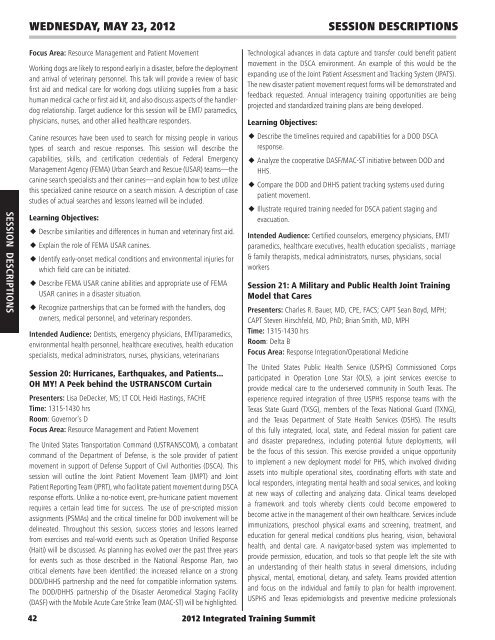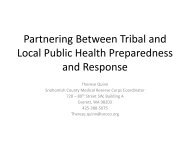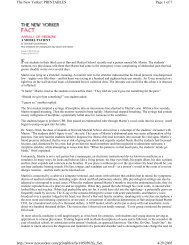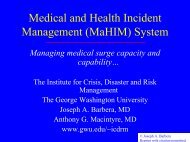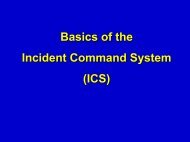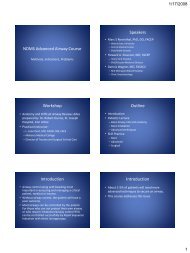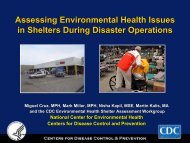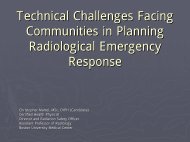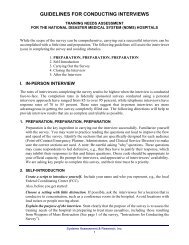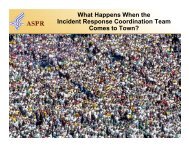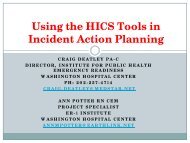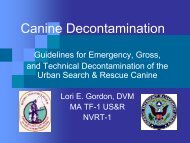wednesday, May 23, <strong>2012</strong>Session Descriptionssession DescriptionsFocus Area: Resource Management and Patient MovementWorking dogs are likely to respond early in a disaster, before the deploymentand arrival of veterinary personnel. This talk will provide a review of basicfirst aid and medical care for working dogs utilizing supplies <strong>from</strong> a basichuman medical cache or first aid kit, and also discuss aspects of the handlerdogrelationship. Target audience for this session will be EMT/ paramedics,physicians, nurses, and other allied healthcare responders.Canine resources have been used to search for missing people in varioustypes of search and rescue responses. This session will describe thecapabilities, skills, and certification credentials of Federal EmergencyManagement Agency (FEMA) Urban Search and Rescue (USAR) teams—thecanine search specialists and their canines—and explain how to best utilizethis specialized canine resource on a search mission. A description of casestudies of actual searches and lessons learned will be included.Learning Objectives:u Describe similarities and differences in human and veterinary first aid.u Explain the role of FEMA USAR canines.u Identify early-onset medical conditions and environmental injuries forwhich field care can be initiated.u Describe FEMA USAR canine abilities and appropriate use of FEMAUSAR canines in a disaster situation.u Recognize partnerships that can be formed with the handlers, dogowners, medical personnel, and veterinary responders.Intended Audience: Dentists, emergency physicians, EMT/paramedics,environmental health personnel, healthcare executives, health educationspecialists, medical administrators, nurses, physicians, veterinariansSession 20: Hurricanes, Earthquakes, and Patients...OH MY! A Peek behind the USTRANSCOM CurtainPresenters: Lisa DeDecker, MS; Lt Col Heidi Hastings, FACHETime: 1315-1430 hrsRoom: Governor’s DFocus Area: Resource Management and Patient Movement<strong>The</strong> United States Transportation Command (USTRANSCOM), a combatantcommand of the Department of Defense, is the sole provider of patientmovement in support of Defense Support of Civil Authorities (DSCA). Thissession will outline the Joint Patient Movement Team (JMPT) and JointPatient Reporting Team (JPRT), who facilitate patient movement during DSCAresponse efforts. Unlike a no-notice event, pre-hurricane patient movementrequires a certain lead time for success. <strong>The</strong> use of pre-scripted missionassignments (PSMAs) and the critical timeline for DOD involvement will bedelineated. <strong>Through</strong>out this session, success stories and lessons learned<strong>from</strong> exercises and real-world events such as Operation Unified Response(Haiti) will be discussed. As planning has evolved over the past three yearsfor events such as those described in the National Response Plan, twocritical elements have been identified: the increased reliance on a strongDOD/DHHS partnership and the need for compatible information systems.<strong>The</strong> DOD/DHHS partnership of the Disaster Aeromedical Staging Facility(DASF) with the Mobile Acute Care Strike Team (MAC-ST) will be highlighted.42Technological advances in data capture and transfer could benefit patientmovement in the DSCA environment. An example of this would be theexpanding use of the Joint Patient Assessment and Tracking System (JPATS).<strong>The</strong> new disaster patient movement request forms will be demonstrated andfeedback requested. Annual interagency training opportunities are beingprojected and standardized training plans are being developed.Learning Objectives:u Describe the timelines required and capabilities for a DOD DSCAresponse.u Analyze the cooperative DASF/MAC-ST initiative between DOD andHHS.u Compare the DOD and DHHS patient tracking systems used duringpatient movement.u Illustrate required training needed for DSCA patient staging andevacuation.Intended Audience: Certified counselors, emergency physicians, EMT/paramedics, healthcare executives, health education specialists , marriage& family therapists, medical administrators, nurses, physicians, socialworkersSession 21: A Military and Public Health Joint TrainingModel that CaresPresenters: Charles R. Bauer, MD, CPE, FACS; CAPT Sean Boyd, MPH;CAPT Steven Hirschfeld, MD, PhD; Brian Smith, MD, MPHTime: 1315-1430 hrsRoom: Delta BFocus Area: Response Integration/Operational Medicine<strong>The</strong> United States Public Health Service (USPHS) Commissioned Corpsparticipated in Operation Lone Star (OLS), a joint services exercise toprovide medical care to the underserved community in South Texas. <strong>The</strong>experience required integration of three USPHS response teams with theTexas State Guard (TXSG), members of the Texas National Guard (TXNG),and the Texas Department of State Health Services (DSHS). <strong>The</strong> resultsof this fully integrated, local, state, and Federal mission for patient careand disaster preparedness, including potential future deployments, willbe the focus of this session. This exercise provided a unique opportunityto implement a new deployment model for PHS, which involved dividingassets into multiple operational sites, coordinating efforts with state andlocal responders, integrating mental health and social services, and lookingat new ways of collecting and analyzing data. Clinical teams developeda framework and tools whereby clients could become empowered tobecome active in the management of their own healthcare. Services includeimmunizations, preschool physical exams and screening, treatment, andeducation for general medical conditions plus hearing, vision, behavioralhealth, and dental care. A navigator-based system was implemented toprovide permission, education, and tools so that people left the site withan understanding of their health status in several dimensions, includingphysical, mental, emotional, dietary, and safety. Teams provided attentionand focus on the individual and family to plan for health improvement.USPHS and Texas epidemiologists and preventive medicine professionals<strong>2012</strong> Integrated Training Summit
wednesday, May 23, <strong>2012</strong>Session Descriptionsteamed together to collect unique data <strong>from</strong> Operation Lone Star. One armof the epidemiological data collection included a household survey, designedspecifically for the OLS clinic, addressing client characteristics, evacuationpreparedness, immunizations, and OLS marketing efforts. Additionalindividual client data were collected <strong>from</strong> medical charts, including age,gender, height, weight, BMI, and chronic medical history. <strong>The</strong> data analysiswill assist OLS and DSHS in targeting future public health interventions tooptimize impact.Learning Objectives:u Explain the structure and function of USPHS medical response teams.u Develop deployment plans for an integrated disaster response orhumanitarian mission.u Describe lessons learned to integrate response among Federal, state,and military assets supporting Operation Lone Star.u List and present suggested remedies for multiple potential problemsencountered during planning, deploying, performing duties, andreturn to station.u Identify best practices that can be applied as a new response modelfor the future.Intended Audience: Dentists, emergency physicians, EMT/paramedics, healthcare executives, health education specialists, medicaladministrators, nurses, physiciansSession 22: <strong>The</strong> HHS Disaster Behavioral HealthCONOPS: Optimizing Public Health and MedicalResponse and <strong>Recovery</strong> for Survivors and RespondersPresenters: Darrin Donato, BA; Rachel Kaul, LCSW, CTS;A. Thomas Mignone, Jr, MPH, REHSTime: 1315-1430 hrsRoom: Governor’s BFocus Area: Response Integration/Operational MedicineDisaster behavioral health is an integral part of the overall public health andmedical preparedness, response, and recovery system. It includes the manyinterconnected psychological, emotional, cognitive, developmental, andsocial influences on behavior, mental health, and substance use/abuse, andthe effect of these influences on preparedness, response, and recovery <strong>from</strong>disasters or traumatic events. Historically, the coordination and effectiveintegration of numerous and diverse behavioral health stakeholders andproviders into the larger health and medical response has been a challengeat Federal, state, and local levels. In December 2010, the Office of theAssistant Secretary for <strong>Preparedness</strong> and Response (ASPR) within the U.S.Department of Health and Human Services (HHS) initiated the HHS DisasterBehavioral Health Concept of Operations (DBH CONOPS) Working Group.<strong>The</strong> working group was comprised of agency representatives across HHSand aimed to develop a CONOPS to provide coordination and guidancefor HHS Federal-level behavioral health preparedness, response, andrecovery action for disasters and public health emergencies. Developmentof a DBH CONOPS is a recommendation of both the National BiodefenseScience Board and the National Commission on Children and Disasters.Effective and well-coordinated behavioral health preparedness, response,and recovery can mitigate or prevent more serious behavioral healthproblems in disaster survivors and responders and promote individual andcommunity resilience. <strong>The</strong> DBH CONOPS describes the overarching conceptualframework that HHS uses to coordinate HHS-wide preparedness, response,and recovery activities in concert with its authorities and responsibilities.<strong>The</strong> goal of the DBH CONOPS is to improve coordination of departmentalpreparedness, response, and recovery efforts concerning behavioral healthin support of state, territorial, tribal, and local efforts in a manner consistentwith the National Response Framework and the National Disaster <strong>Recovery</strong>Framework. Facilitated discussion about state and local response andrecovery activities and how these are supported through the DBH CONOPSwill also be a focus of the session. This interactive session will allowparticipants with and without behavioral health expertise to considerhow disaster behavioral health preparedness efforts can support existingoperational guidance at the Federal level and can enhance and informoverall emergency response and recovery at Federal, state, and local levels.Learning Objectives:u Identify the most common evidence-informed disaster behavioralhealth activities and interventions used to support survivors andresponders at the Federal, state, and local levels.u Describe the key elements of the Disaster Behavioral Health CONOPSand identify key roles and responsibilities of HHS operating and staffdivisions in disaster behavioral health response and recovery.u Discuss how the content of the Disaster Behavioral Health CONOPScan inform and optimize overall public health and medical responseand recovery <strong>from</strong> disasters and public health emergencies.Intended Audience: Certified counselors, emergency physicians, EMT/paramedics, healthcare executives, health education specialists, marriage& family therapists, medical administrators, nurses, physicians, socialworkersSession 23: Responder Risk in Crisis Standards of CarePresenters: Dan Hanfling, MD, FACEP; CAPT Kenneth Harman, MD;Fred Henretig, MD; Merritt Schreiber, PhDTime: 1515-1645 hrsRoom: Delta BFocus Area: Joint SessionRecently, the Institute of Medicine (IOM) released reports andrecommendations on implementing crisis standards of care (CSC) in healthemergencies. One cross-cutting component of the IOM recommendationsis the need to address the impact of implementing CSC on healthcareworkers. Although many healthcare workers confront life and deathdecisions on a daily basis, the nature of crisis standards of care involvesfundamental differences in both the qualitative and quantitative aspectsof many healthcare stressors. Consequently, the IOM Committee on CrisisStandards of Care has developed a number of key force health protectionactions involving leadership of diverse healthcare systems and healthcareworkers themselves. <strong>The</strong> recommendations will be presented and reviewedby several members of the IOM CSC, including the primary developer of theforce mental health protection recommendations.session Descriptions<strong>2012</strong> Integrated Training Summit 43
- Page 1 and 2: Leading from PreparednessThrough Re
- Page 3 and 4: Table of ContentsAmericans with Dis
- Page 5 and 6: Integrated Training Summit Partner
- Page 7 and 8: Focus area DescriptionsFocus Area D
- Page 9 and 10: Late Breakers & Early RisersTuesday
- Page 11 and 12: Handy Perforated Daily Agendas - De
- Page 13 and 14: Handy Perforated Daily Agendas - De
- Page 15 and 16: Handy Perforated Daily Agendas - De
- Page 17 and 18: Handy Perforated Daily Agendas - De
- Page 19 and 20: WorkshopDescriptions2012 Integrated
- Page 21 and 22: Monday, May 21, 2012Workshop Descri
- Page 23 and 24: MoNday, May 21, 2012Workshop Descri
- Page 25 and 26: MoNday, May 21, 2012Workshop Descri
- Page 27 and 28: Tuesday, May 22, 2012Workshop Descr
- Page 29 and 30: WEDNESday, May 23, 2012dMIS Worksho
- Page 31 and 32: ThurSday, May 23, 2012dMIS Workshop
- Page 33 and 34: SessionDescriptionssession Descript
- Page 35 and 36: wednesday, May 23, 2012Session Desc
- Page 37 and 38: wednesday, May 23, 2012Session Desc
- Page 39 and 40: wednesday, May 23, 2012u Provide ex
- Page 41: wednesday, May 23, 2012Session Desc
- Page 45 and 46: Thursday, May 24, 2012Session Descr
- Page 47 and 48: THURsday, May 24, 2012Session Descr
- Page 49 and 50: THURsday, May 24, 2012Session Descr
- Page 51 and 52: THURsday, May 24, 2012Session Descr
- Page 53 and 54: THURsday, May 24, 2012Session Descr
- Page 55 and 56: THURsday, May 24, 2012Session Descr
- Page 57 and 58: FRIday, May 25, 2012Session Descrip
- Page 59 and 60: Tuesday, May 22, 2012MRC WorkshopsM
- Page 61 and 62: Tuesday, May 22, 2012MRC WorkshopsL
- Page 63 and 64: Continuing Education InformationCon
- Page 65 and 66: Continuing Education InformationSes
- Page 67 and 68: Planning CommitteeDawn AnastasiaChe
- Page 69 and 70: PresentersBrian Abrahamson, BAGaylo
- Page 71 and 72: PresentersMary Massey, BSN, MA, MEP
- Page 73 and 74: Presenter DisclosuresAlliance betwe
- Page 75 and 76: 2012 Poster PresentationsMRCPoster
- Page 77 and 78: 2012 Poster PresentationsApplicatio
- Page 79 and 80: 2012 Poster PresentationsCollaborat
- Page 81 and 82: 2012 Poster PresentationsEducation
- Page 83 and 84: 2012 Poster PresentationsSpecial Co
- Page 85 and 86: Integrated Training Summit Acronym


